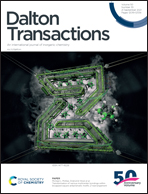Cryogenic enabled multicolor upconversion luminescence of KLa(MoO4)2:Yb3+/Ho3+ for dual-mode anti-counterfeiting†
Abstract
The rational development of multicolor upconversion (UC) luminescent materials is particularly promising for achieving high-tech anti-counterfeiting and security applications. Here, an Ho3+ and Yb3+ ion co-doped KLa(MoO4)2 material can achieve multicolored UC luminescence by thermally manipulating the electron transition process, which could be developed to execute advanced optical anti-counterfeiting applications. The emission color of this material turns from bright green to deep orange with the temperature controlled from 85 K to 240 K in a cryogenic environment. The maximum absolute sensitivity and relative sensitivity of this temperature-sensing material based on non-thermally coupled levels of Ho3+ ions reached 0.049 K−1 and 4.6% K−1. And utilizing the thermochromic luminescence properties and high sensitivity for low temperature of the KLa(MoO4)2:Yb3+/Ho3+ UC material, we created KLa(MoO4)2:Yb3+/Ho3+ fluorescent security inks and UC photonic barcodes to realize novel visual reading and digital recognition dual-mode anti-counterfeiting in a secure manner. These results may provide useful enlightenment for the design and modulation of high-sensitivity temperature-sensing materials for high-level anti-counterfeiting applications.



 Please wait while we load your content...
Please wait while we load your content...